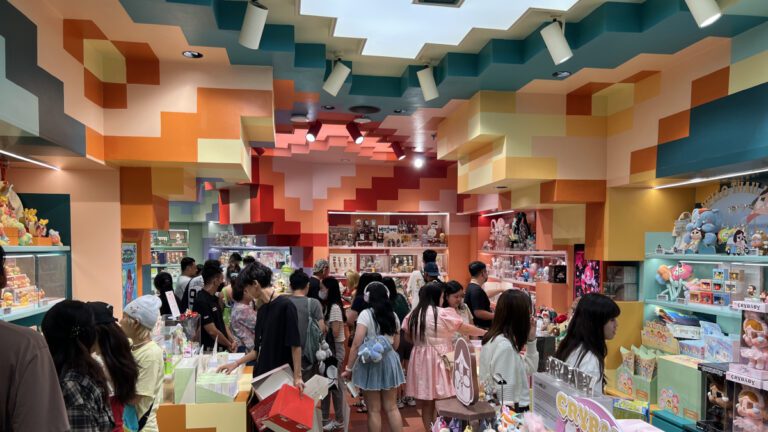Bangkok | Guest author Florian Bogeschdorfer takes us on a vivid tour of Pop Mart’s newest flagship in Bangkok – a 760-square-meter spectacle of designer toys, pastel architecture, and immersive retail storytelling. Whether you’re a signage strategist or a retail designer, this is one store you need to see to believe.
Bangkok’s Iconsiam Mall – widely regarded as the city’s most architecturally striking mall – recently unveiled a new kinetic art installation: a circular waterfall with a programmable water curtain capable of forming letters mid-air. Yet the crowd gathered nearby was drawn to a different spectacle entirely. Even ten days after the grand opening, the queue for Pop Mart’s new flagship store still spanned two floors, with eleven security guards managing crowd flow from the upper level and escorting visitors in batches to the entrance. Notably, the line consisted entirely of adults.
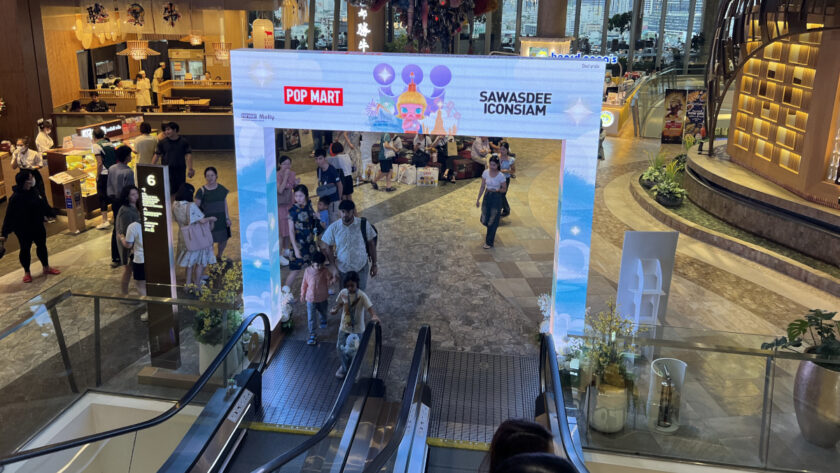
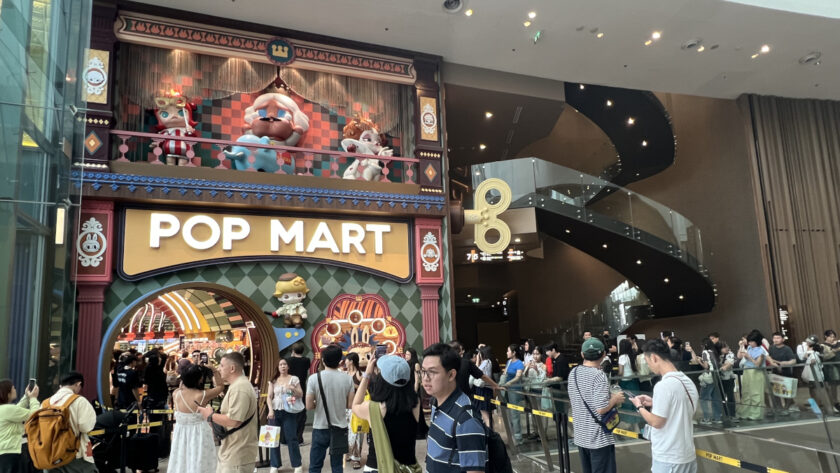

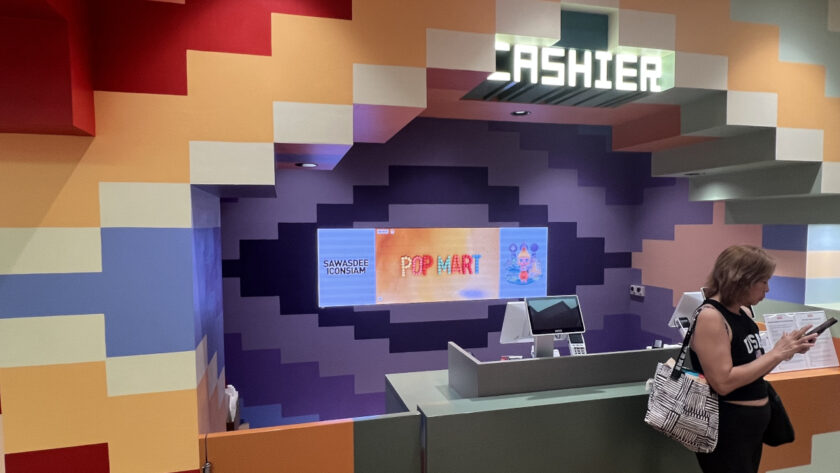
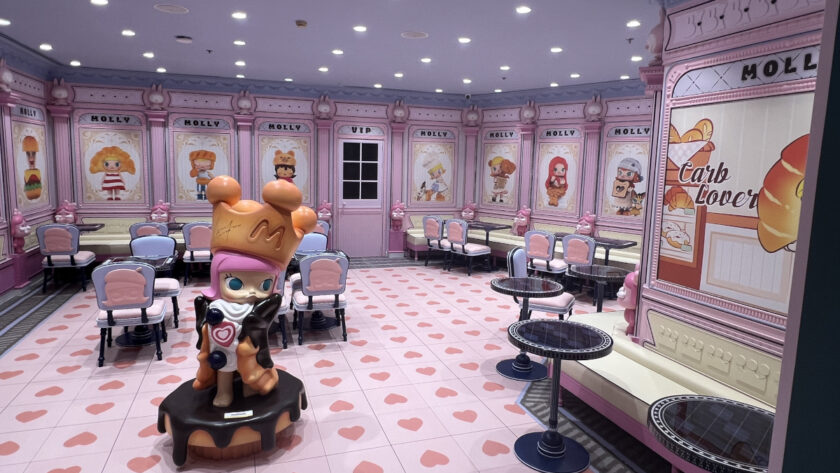
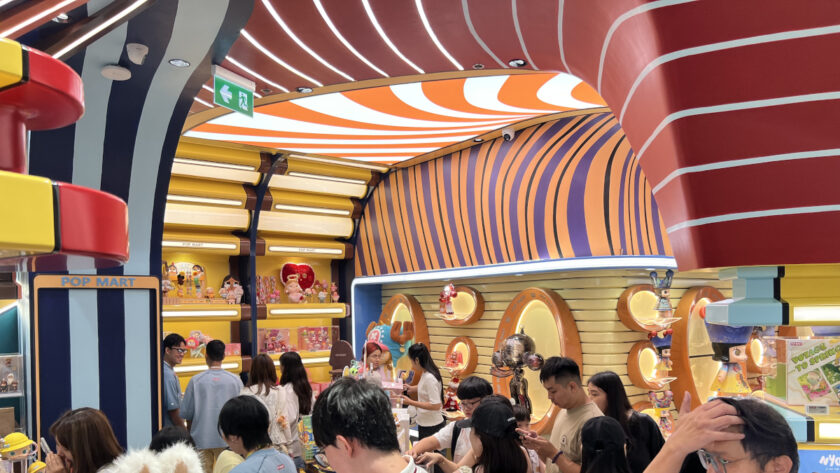
Retro-Futuristic meet Electic Product Assortment
Opened on August 8th, the 760-square-meter store is now the world’s largest Pop Mart location, dedicated exclusively to collectible designer toys. From the exterior, the store resembles a theme park attraction, complete with a wind-up mechanism and a pastel-toned, retro-futuristic façade evoking 1950s Americana. Inside, the layout is deliberately disorienting – rounded forms, vibrant stripes, and a lack of conventional room structures create an immersive, dreamlike environment reminiscent of a psychedelic Charlie and the Chocolate Factory. According to Pop Mart, the design draws inspiration from Bangkok’s urban vibrancy, including Tuk-Tuks, traditional textiles, and the winding Chao Phraya River.
The product assortment is equally eclectic. While Pop Mart’s core offerings include Chinese and Japanese collectibles like Labubu and Skullpanda, the brand has expanded through licensing agreements with global IPs such as Disney, Marvel, DC, and Barbie. Blind box formats dominate, with characters ranging from Minions to Sponge Bob, available in multiple sizes and themes. The thrill of discovery – combined with limited editions and social media-driven resale value – fuels a collector’s mindset. I found myself tempted by a 160 Euro “Durian Man” figure, a moment that clarified the brand’s emotional and commercial appeal.
Global Brand with Local Touch
What stood out most was the localized merchandising strategy. Thai cultural references permeate the store – from architectural motifs to exclusive product variants – demonstrating a nuanced regional adaptation of a global retail concept. Store navigation is intentionally non-linear; aside from the entrance and exit, directional signage is minimal. Visitors are encouraged to wander, encountering not-for-sale display pieces alongside boxed merchandise, with brand collections dispersed throughout the space.
Upstairs, a Pop Mart café in soft pink hues is slated to open soon. Digital signage is limited to the ground floor behind the checkout counters, while subtle LED character animations are seamlessly embedded into the first-floor design. A visit to this store is essential for anyone studying experiential retail environments. Just be warned: the impulse to spend is built into the architecture.
Background Pop Mart
Founded in Beijing in 2010, Pop Mart has built an omni-channel ecosystem spanning more than 500 flagship stores and 2,600 vending machines, with aggressive international expansion underway across Southeast Asia and the U.S. The most popular character Labubu, designed by Kasing Lung, anchors the brand’s cultural momentum – each new series is a narrative-driven drop that sparks social media buzz, long queues, and secondary market activity.
Pop Mart, China’s leading designer toy company, has seen explosive growth driven by the global success of its flagship character, Labubu. In the first half of the year, sales surged to almost 2bn USD – more than tripling year-over-year – and catapulted the brand’s valuation to more than double that of industry giants Hasbro and Mattel combined. Central to Pop Mart’s strategy is the blind box format, which fuels repeat purchases and collector engagement by concealing the exact toy inside each package. This gamified approach, paired with limited editions and tightly timed releases, has created a high-frequency, high-loyalty retail model.
While digital signage is not at the center of the store design, the curated retail environments, regional adaptations, and a clear merchandising playbook makes Pop Mart a compelling blueprint for experiential retail and collectible commerce.


